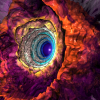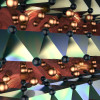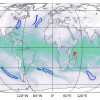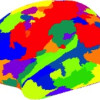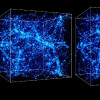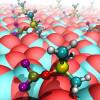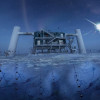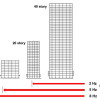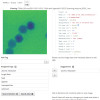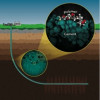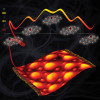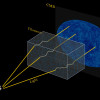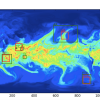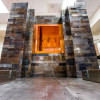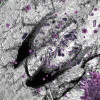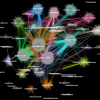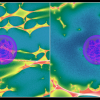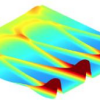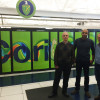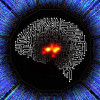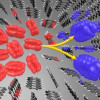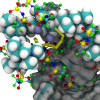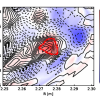Science News
Shedding New Light on Luminous Blue Variable Stars
Three-dimensional simulations run at NERSC, Argonne and NASA have provided new insights into the behavior of a unique class of celestial bodies known as luminous blue variables - rare, massive stars that can shine up to a million times brighter than the Sun. Read More »
Simulations Run at NERSC Confirm Thermal and Electrical Properties of Superionic Crystals
Using a combination of experiments and simulations, materials scientists at Duke University, Oak Ridge National Laboratory and Argonne National Laboratory have sussed out the physical phenomenon underlying the promising electrical and thermal properties of a class of materials called superionic crystals. Read More »
Berkeley Lab, Oak Ridge, NVIDIA Team Breaks Exaop Barrier With Deep Learning Application
A team of computational scientists from Berkeley Lab and Oak Ridge National Laboratory and engineers from NVIDIA has, for the first time, demonstrated an exascale-class deep learning application that has broken the exaop barrier. Read More »
HP-CONCORD Paves the Way for Scalable Machine Learning in HPC
A team of Berkeley Lab researchers has demonstrated how a new parallel algorithm called HP-CONCORD can help address some of the most challenging problems in data-driven science. Read More »
NERSC, Intel, Cray Harness the Power of Deep Learning to Better Understand the Universe
A Big Data Center collaboration between computational scientists at NERSC and engineers at Intel and Cray has yielded another first in the quest to apply deep learning to data-intensive science: CosmoFlow, the first large-scale science application to use the TensorFlow framework on a CPU-based high performance computing platform with synchronous training. Read More »
Topology, Physics & Machine Learning Take on Climate Research Data Challenges
Two PhD students who first came to Berkeley Lab as summer interns in 2016 are spending six months a year at the lab through 2020 developing new data analytics tools that could dramatically impact climate research and other large-scale science data projects. Read More »
Berkeley Lab Researchers Showcase Deep Learning for High Energy Physics at CHEP
Steve Farrell, a machine-learning engineer who recently joined NERSC, gave an overview of Berkeley Lab’s expanding expertise in deep learning for science during a plenary talk at the 2018 CHEP conference in July. Read More »
Batteries Get a Boost from ‘Pickled’ Electrolytes
Battery researchers at Argonne National Laboratory used computer simulations to help reveal the mechanism behind a common additive known to extend the life of lithium-ion batteries. Read More »
Berkeley Lab-Developed Digital Library is a Game Changer for Environmental Research
Developed by Berkeley Lab, NERSC and NCEAS researchers, ESS-DIVE is a new digital archive that serves as a repository for hundreds of U.S. Department of Energy-funded research projects under the agency’s Environmental System Science umbrella. Read More »
IceCube Neutrinos Point to Long-Sought Cosmic Ray Accelerator
An international team of scientists has found the first evidence of a source of high-energy cosmic neutrinos, ghostly subatomic particles that can travel unhindered for billions of light years from the most extreme environments in the universe to Earth. Read More »
NOvA experiment sees strong evidence for antineutrino oscillation
The Fermilab NOvA neutrino experiment announced that it has seen strong evidence of muon antineutrinos oscillating into electron antineutrinos over long distances, a phenomenon that has never been unambiguously observed. Image: Sandbox Studio Read More »
New Simulations Break Down Potential Impact of a Major Quake by Building Location and Size
A team of Berkeley Lab and LLNL researchers is leveraging powerful supercomputers at NERSC to portray the impact of high-frequency ground motion on thousands of representative different-sized buildings spread out across the California region. Read More »
Berkeley Researchers Use Machine Learning to Search Science Data
Science Search, a web-based search engine for scientific data is currently being developed by a team of researchers in Berkeley Lab's CRD and NERSC. The team is also developing innovative machine learning tools to pull contextual information from scientific datasets and automatically generate missing metadata tags for each file. As a proof-of-concept, the team is working with staff at the Molecular Foundry, to demonstrate the concepts of Science Search on the images captured by the facility's instruments. Read More »
Self-Healing Cement Could Be a Boon to Oil & Gas Industry
Researchers at Pacific Northwest National Laboratory have developed a unique cement that can repair itself in as little as a few hours; simulations run at NERSC helped them understand how it works. Read More »
Quarterbacking Catalysts by Positioning Atoms
Materials science researchers at Pacific Northwest National Laboratory used experiments involving graphene, along with calculations run at NERSC, to better understand how oxygen atoms bind with graphene and turn graphene into a unique catalytic support. Read More »
Tiny Distortions Reveal Clearer Picture of Strands in Cosmic Web
Scientists have decoded faint distortions in the patterns of the universe’s earliest light to map huge tubelike structures invisible to our eyes – known as filaments – that serve as superhighways for delivering matter to dense hubs such as galaxy clusters. Read More »
Deep Learning at 15 PFlops Enables Training for Extreme Weather Identification at Scale
Petaflop per second deep learning training performance on the Cori supercomputer at NERSC has given climate scientists the ability to use machine learning to identify extreme weather events in huge climate simulation datasets. Read More »
Underground Neutrino Experiment Could Provide Greater Clarity on Matter-Antimatter Imbalance
A new underground neutrino experiment could provide greater clarity on matter-antimatter imbalance in the Cosmos. And NERSC will be the principal site for data processing and analyses throughout the course of the experiment. Read More »
NERSC Supercomputers Help Researchers Create Reference Catalog for Rumen Microbiome
Using supercomputers at NERSC, an international team led by William Kelly, formerly at AgResearch New Zealand’s Grasslands Research Centre, and including scientists at the Joint Genome Institute generated a reference catalog of rumen microbial genomes and isolates cultivated and sequenced from the Hungate1000 collection. Read More »
A Game Changer: Metagenomic Clustering Powered by HPC
A team of researchers from Berkeley Lab's CRD and JGI took one of the most popular clustering approaches in modern biology—the Markov Clustering algorithm—and modified it to run quickly, efficiently and at scale on distributed-memory supercomputers. Read More »
Can Strongly Lensed Type Ia Supernovae Resolve One of Cosmology’s Biggest Controversies?
Using the SciDAC developed SEDONA code and NERSC supercomputers, astrophysicists at Berkeley Lab and the University of Portsmouth discovered how to control the effects of "micolensing." Armed with this knowledge they believe they will be able to find 1000 strongly lensed Type Ia supernovae in real-time from LSST data--that's 20 times more than previous expectations. Read More »
The Atomic Dynamics of Rare Magneto-Electric Matter
By ricocheting neutrons off the atoms of yttrium manganite (YMnO3) heated to 3,000 degrees Fahrenheit, researchers have discovered the atomic mechanisms that give the unusual material its rare electromagnetic properties. Their work included quantum simulations run at NERSC. Read More »
Physics Data Processing at NERSC Dramatically Cuts Reconstruction Time
In a recent demonstration project, physicists from Brookhaven National Laboratory and Berkeley Lab used the Cori supercomputer to reconstruct data collected from a nuclear physics experiment, an advance that could dramatically reduce the time it takes to make detailed data available for scientific discoveries. Read More »
Delivering Efficient Parallel I/O with HDF5 on Exascale Computing Systems
In an interview with Department of Energy's ECP communications team, Berkeley Lab's Suren Byna and Quincey Koziol talk about delivering efficient parallel I/O with HDF5 on exascale computing systems. Read More »
Berkeley Lab Physicists Apply Machine Learning to the Universe’s Mysteries
Berkeley Lab physicists and their collaborators have demonstrated that computers are ready to tackle the universe’s greatest mysteries – they used neural networks to perform a deep dive into data simulating the subatomic particle soup that may have existed just microseconds after the big bang. Read More »
Charting a New Course in Organic Solar Cell Design
Scientists have pinpointed the source of an ultrafast and efficient process that spawns several carriers of electrical charge from a single particle of light in organic crystals that are integral to this increasingly popular form of solar cells. Read More »
Coupling Experiments to Theory to Build a Better Battery
A research team led by Berkeley Lab found that a new lithium-sulfur battery component allows a doubling in capacity compared to a conventional lithium-sulfur battery. Read More »
The Blob that Ate the Tokamak
Scientists at Princeton Plasma Physics Laboratory used NERSC resources to create new simulations that could provide insight into how blobs (bubbles) at the plasma edge in a tokamak reactor behave. Read More »






